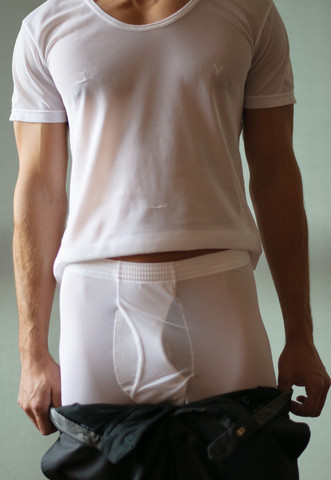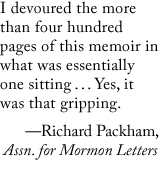Not many people outside of Utah may be aware of it, but a controversy is brewing—and it has to do with Mormon underwear.
Specifically, it has to do with the portrayal of Mormon underwear on network television. As reported by Scott D. Pierce of The Salt Lake Tribune, next month's premiere episode of the new ABC series "Quantico" will feature a scene in which a young FBI recruit appears on screen in only his "garments," the sacred underclothes that many Mormons wear next to their skin.
Why is this controversial? It's not like garments are very racy, since they're meant to cover the body from the shoulders to the knees. (I, in fact, find them downright offputting, though I'm sure garments have their fetishists.) The problem is that most Mormons consider garments—which are stitched with arcane though unobtrusive symbols meant to remind the wearer of covenants made in the temple—to be sacred, and not intended for the prying eyes of outsiders.
This apparent secretiveness and sensitivity about garments has made them ripe for mockery. Most people, even if they know nothing else about the church, "know" that Mormons wear "magic underwear" to protects them from physical and spiritual harm. One of the most frequent questions I get, in fact, when someone finds out I'm a former Mormon, is: "Is it true about the magic underwear?"
Mormons first don their garments during a solemn washing and anointing ceremony in the temple that is a prelude to the even more solemn "endowment" ceremony. I myself can testify to the power and significance with which these rituals imbue the garments. I went through my first endowment in 1986. By 1995 I was several years into a slow slide out of the church, but a kind of terror over the state of my soul had not yet allowed me to feel safe about not wearing my garments.I was living in Seattle that summer, and I went to see a local production of Tony Kushner's play "Angels in America." A lot of the politics of it went over my head, but what I remember to this day is how shocked and disturbed I was to see a Mormon character appear on stage in just his garments.
Sacrilege! I thought, my stomach in knots. Blasphemy!
I wrestled for weeks with my reaction to that casual moment in the play, so I can understand why Mormons now are reacting with concern and disquiet to the prospect of seeing garments portrayed on "Quantico." They don't want what is sacred to them held up to ridicule and mockery.
But the problem with that attitude is twofold. First, I doubt the producers of the series are intending any mockery or sacrilege. They're simply trying to offer a realistic portrayal of a Mormon in a normal, everyday situation.
Second, the garments are already a subject for ridicule. The very secrecy and mystery around them is what makes them ripe for mockery. The only way to defuse that is to make them less mysterious. And the only way to do that is to tolerate open discussion about them, which includes portrayals in popular culture.
Open, respectful discussion, in fact, is probably what the Mormon Church had in mind last year when it released an informational video about garments on its web site. The topic is out there. Even the church has had to admit that it's not practical to keep its garments entirely hidden, even if it's still trying to control the narrative.
Taboo areas like this are why, I think, Mormons as a people have been so slow to develop a literature, theater, and cinema that are accessible to general audiences and can stand with the best works those fields produce. Unlike works by, say, Catholics or Jews, what does break through tends to come from artists who have put themselves entirely outside of Mormon practice and society.
The tendency within the church is to expect that works by and about Mormons can only be valuable insofar as they are instructive or uplifting. This discourages artists from tackling taboo subjects (unless it's from a doctrinaire standpoint), or even from mentioning sacred cows such as garments. This approach does not produce art—it produces propaganda, not to mention an unwillingness to engage with or even tolerate depictions of "sacred" subjects. This is an insularity that only feeds back on itself.
Nor is this just a problem for the consumers of art. The fear of audience censure may prevent otherwise worthwhile works from even being created, or at least from achieving their full power. When I was writing the first draft of The Accidental Terrorist, I had already been out of the church and out of Utah for a few years, but still I did not want to write about my experience of the endowment ceremony. Not only did I fear offending family and friends and alienating potential readers, but those experiences, however scarring, were so deeply internalized as sacred and unmentionable (see what I did there?) that I felt dread every time I contemplated committing them to paper. I did everything I could to find a way around it.
In the end, the book won, as it probably always should. The endowment was a signature experience in my life, and there was no way for me to tell my story honestly and make it understandable without attempting to portray that. Sacred and oath-bound or not, it had to be in there for the story I needed to tell to make sense.
If it seems like we've strayed far from the topic of weirdly unrevealing underwear on television, we really haven't. Mormons often complain about being misunderstood. Well, if they really want the rest of us to understand them, then sometimes that means letting us see them with their pants down.
Crossposted from Inhuman Swill



